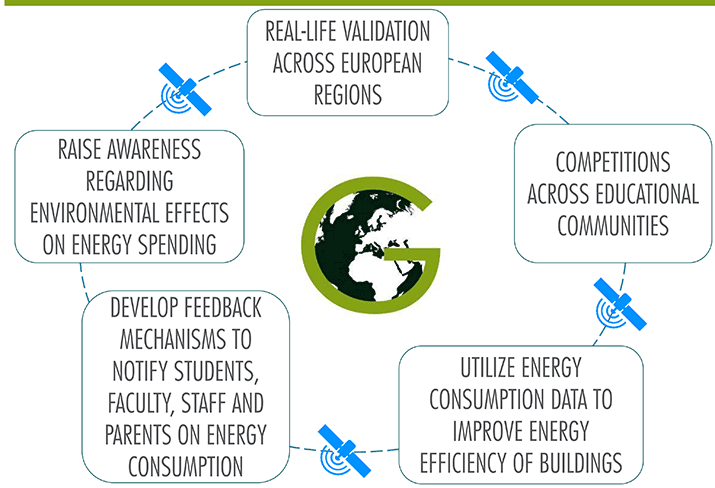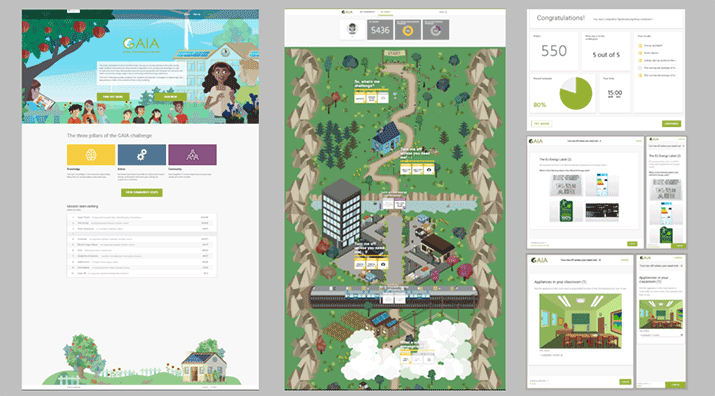Green Awareness via IoT Infrastructure, Educational Labs and Games in Schools: The GAIA Case
Irene Mavrommati and Joerg Hofstaetter
Educational buildings constitute 17% of the non-residential building stock in the EU [1], while recent work shows that a focus on energy use in schools can potentially yield an array of rewards, in concert with educational excellence and a healthy learning environment [2]. Having these in mind, GAIA 1, a Horizon2020 EC-funded project, is developing an IoT platform that combines sensing, web-based and gamification elements, in order to address the educational community. Its primary aim is to increase awareness about energy consumption and sustainability, based on real sensor data produced by the school buildings where students and teachers live and work, while also lead towards behavior change in terms of energy efficiency.
We believe that a participatory, ethical and sustainable engagement of students is a meaningful way to enable greater understanding of these concepts and lead to future well-informed, responsible and active citizens. In this sense, an approach based on open-source, replicable and widely available technology, providing a “foundation” that lets educators to adapt to the needs of each class, opens up many possibilities. To change the behavior and achieve sustainable results, GAIA utilizes a loop approach focused around 3 pillars: raise awareness, support action, and foster engagement. An overview of GAIA’s goals can be seen in Figure 1.

Figure 1: One way to achieve GAIA goals, outlined in this image, is by providing students with game challenges, which use real sensor data from their school.
IoT infrastructure in GAIA: classroom nodes and educational lab kits
Currently, 18 educational building sites participate in GAIA, located in Sweden, Italy and Greece, aiming to cut down on their energy consumption. The total number of students in these sites is around 5500. An IoT infrastructure with 855 sensing points has been installed in these buildings to monitor energy consumption, as well as indoor and outdoor environmental parameters (temperature, light, humidity, movement, noise levels). Real-time feedback, stemming from the actual IoT sensors data, is provided via a number of user interfaces, community support tools, and a game.
The GAIA application set complements an educational approach that encourages customization to the specific requirements of each school. It is also accompanied by an educational lab kit and respective content, which will allow students to experiment with IoT nodes similar to the ones installed as school infrastructure. The lab kit is based on popular DIY electronics components, such as Raspberry Pi and conductive ink, and will be utilized by the students to implement “basic” IoT solutions to monitor their own environment (see Figure 2).

Figure 2: IoT nodes used in GAIA.
GAIA challenge and trials at schools

The GAIA Challenge2 is an online serious game for students, designed to raise energy awareness within their own facility. In addition, real-time data from sensors in the buildings and participatory sensing are a part of the challenge; the aim is to visualize the real-life impact of the participants’ behavior and build collaborative (within a facility) and competitive (between facilities) gamification elements upon the real-life impact. The game challenge utilizes gamification mechanics to:
- motivate participants to engage in energy saving topics;
- work on online “quests”;
- participate in real-life activities;
- experience their impact on the facilities’ energy consumption over the course of the challenge;
- compete and compare against other classes and schools in other countries;
- share their experience within their peer group.
The online challenge is modular enough in order to support the diverse communities (from elementary schools to secondary schools and universities) and diverse knowledge items (energy efficiency for different energy sources, control of the room climate, resource sharing, etc.). Furthermore, it is localized in a number of languages, and includes diverse activities completed either on individual basis, or a class/group basis, either digital (e.g., filling in multiple-choice questions), or physical (e.g., monitoring the power consumption meters). To meet these requirements, local teachers are involved in Class Activities to work together with their students on hands-on observation and optimization tasks in classrooms.
For the validation of the GAIA services and applications, a set of trials will commence in October 2017 across Europe (Greece, Italy and Sweden), representing different climate zones, building age categories and socio-economic criteria. The GAIA Challenge has already been tested by 615 students of primary and secondary education, in May 2017, at the end of the school year. The game was primarily played by groups of students within the course of an educational activity.
Challenges and threats
A number of unique features and challenges exist in GAIA’s technical domain. Educational organizations (e.g., ministries) manage a large number of buildings. Additionally, in many cases existing school buildings are often quite old, have central heating or cooling, having limited possibilities in control, etc. Moreover, such entities wish to avoid vendor lock-in, while a single solution in terms of infrastructure is impossible, since each educational building has different characteristics. Furthermore, since we are talking about the educational community, data should be utilized in an educational setting. GAIA attempts to tackle these challenges by using standards-based solutions that follow current engineering practices, while being open-source-based as much as possible.
A serious challenge is also the overall educational strategy of the project. While previous similar projects have taken an approach based on providing ready-made solutions, with a concrete set of educational material to be used in classes, this is not an ideal solution. In many cases, schools have unique schedules and characteristics that cannot be handled with a one-size-fits-all approach, especially when discussing activities that are outside of the standard curriculum dictated e.g., by the national ministries of education. GAIA will attempt to provide the tools on top of which educators can adapt their own lectures and schedule.
With respect to the design of the application toolset, GAIA’s end-user communities include people of diverse age, which implies that different communication channels have to be supported. In addition, customization to the automation level of each school is mandatory. Moreover, the localization of the application is crucial for the penetration of the applications and this does not refer only to language but also to the roles and availability of staff to implement energy efficiency campaigns. E.g., while in Sweden the role of building manager is held by dedicated personnel, in public schools in Greece and in Italy, this role is undertaken by school principals. Additionally, there are fears over privacy issues related to the IoT. Such issues are handled by being completely transparent in terms of what is being monitored inside schools, while also using anonymization in the produced datasets.
References
- Europe’s buildings under the microscope: A country-by-country review of the energy performance of buildings. Technical report, Buildings Performance Institute Europe (BPIE), 2011. ISBN: 9789491143014
- K. Crosby and A. B. Metzger. Powering down: A toolkit for behavior-based energy conservation in k-12 schools. Technical report, U.S. Green Building Council (USGBC), 2012.
1GAIA project website, http://gaia-project.eu
2GAIA Challenge website, http://gaia-challenge.com/
 Georgios Mylonas is a senior researcher at Computer Technology Institute and Press “Diophantus”, Patras, Greece. He received his Ph.D., MSc and diploma degree from the Dpt. of Comp. Engineering and Informatics at the University of Patras. His research interests lie in the areas of IoT, wireless sensor networks, distributed systems and pervasive games. He has been involved in the AEOLUS, WISEBED, Smartsantander, AUDIS and OrganiCity projects, focusing on algorithmic and software issues of wireless sensor networks. He is currently the coordinator of the Green Awareness in Action (GAIA) H2020 project.
Georgios Mylonas is a senior researcher at Computer Technology Institute and Press “Diophantus”, Patras, Greece. He received his Ph.D., MSc and diploma degree from the Dpt. of Comp. Engineering and Informatics at the University of Patras. His research interests lie in the areas of IoT, wireless sensor networks, distributed systems and pervasive games. He has been involved in the AEOLUS, WISEBED, Smartsantander, AUDIS and OrganiCity projects, focusing on algorithmic and software issues of wireless sensor networks. He is currently the coordinator of the Green Awareness in Action (GAIA) H2020 project.
 Dimitrios Amaxilatis received the B.S. in Computer Engineering and M.S. in Computer Science from the University of Patras, in 2011 and 2013 and is currently a Ph.D. student in the same University. From 2010, he has been a researcher with the Computer Technology Institute in Patras, Greece. He was also member of the founding teams of two technological startups in the fields of microprocessor programming (codebender.cc) and home automation (Sensorflare), as well as the Patras hackerspace (P-Space). His research interests include distributed algorithms, wireless sensor networks, home and building automation, smart city and participatory sensing applications.
Dimitrios Amaxilatis received the B.S. in Computer Engineering and M.S. in Computer Science from the University of Patras, in 2011 and 2013 and is currently a Ph.D. student in the same University. From 2010, he has been a researcher with the Computer Technology Institute in Patras, Greece. He was also member of the founding teams of two technological startups in the fields of microprocessor programming (codebender.cc) and home automation (Sensorflare), as well as the Patras hackerspace (P-Space). His research interests include distributed algorithms, wireless sensor networks, home and building automation, smart city and participatory sensing applications.
 Irene Mavrommati is Assistant Professor at Hellenic Open University, initially trained as interaction/UX/UI designer. She has participated, acquired and led EU Future Emerging Technology (FET) research projects and served as steering group of the Disappearing Computer network and Ubicomp related conferences. She is active in interactive art installations and technology exhibitions, and has authored book chapters and research articles focusing in interaction within ambient computing environments.
Irene Mavrommati is Assistant Professor at Hellenic Open University, initially trained as interaction/UX/UI designer. She has participated, acquired and led EU Future Emerging Technology (FET) research projects and served as steering group of the Disappearing Computer network and Ubicomp related conferences. She is active in interactive art installations and technology exhibitions, and has authored book chapters and research articles focusing in interaction within ambient computing environments.
 Jörg Hofstätter is founder and managing partner of ovos, a digital design agency in Vienna. At Ovos, Jörg is responsible for business development for Online projects and games. He is a trained Architect at the academy of applied arts Vienna at Studio Hadid and has dealt with online technologies and Games for over 15 years. He is frequently invited to international conferences to speak about Serious Games and virtual/augmented space.
Jörg Hofstätter is founder and managing partner of ovos, a digital design agency in Vienna. At Ovos, Jörg is responsible for business development for Online projects and games. He is a trained Architect at the academy of applied arts Vienna at Studio Hadid and has dealt with online technologies and Games for over 15 years. He is frequently invited to international conferences to speak about Serious Games and virtual/augmented space.
Sign Up for IoT Technical Community Updates
Calendar of Events
IEEE 8th World Forum on Internet of Things (WF-IoT) 2022
26 October-11 November 2022
Call for Papers
IEEE Internet of Things Journal
Special issue on Towards Intelligence for Space-Air-Ground Integrated Internet of Things
Submission Deadline: 1 November 2022
Special issue on Smart Blockchain for IoT Trust, Security and Privacy
Submission Deadline: 15 November 2022
Past Issues
September 2022
July 2022
March 2022
January 2022
November 2021
September 2021
July 2021
May 2021
March 2021
January 2021
November 2020
July 2020
May 2020
March 2020
January 2020
November 2019
September 2019
July 2019
May 2019
March 2019
January 2019
November 2018
September 2018
July 2018
May 2018
March 2018
January 2018
November 2017
September 2017
July 2017
May 2017
March 2017
January 2017
November 2016
September 2016
July 2016
May 2016
March 2016
January 2016
November 2015
September 2015
July 2015
May 2015
March 2015
January 2015
November 2014
September 2014


